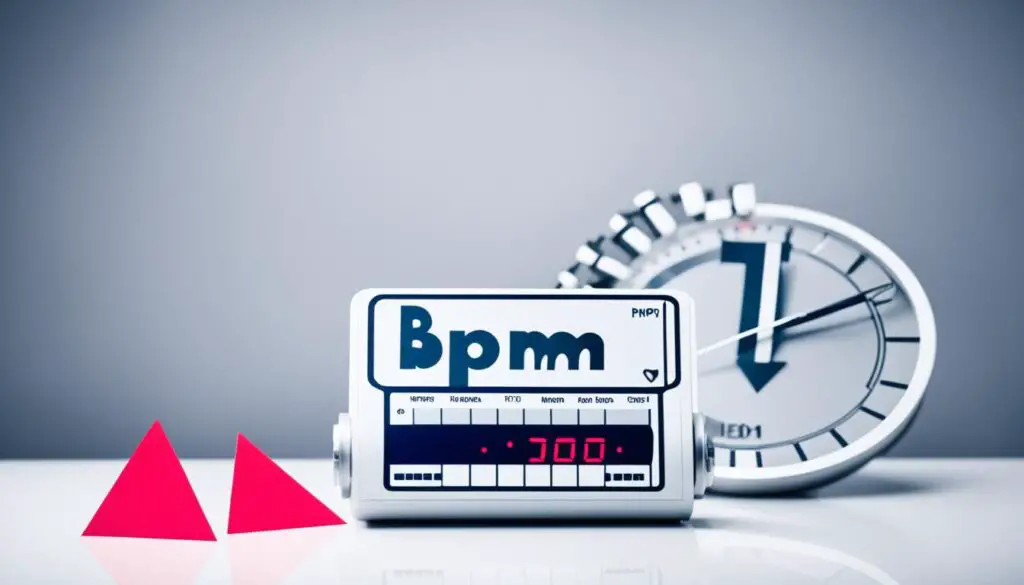How do you choose the right BPM for a mashup?
Choosing the right BPM is key for making great vocals-over-beat mashups. The BPM sets the music’s speed and must match the vocal and beat tracks for a smooth mix. It’s vital to keep the BPM the same for both tracks to avoid any awkward pauses or speed issues.
In music production and audio mixing, knowing about BPM is crucial. DJs, producers, and vocal artists use it to make engaging vocals-over-beat mashups. By setting the same tempo for the vocal and beat, they create a seamless and engaging sound for listeners.
Understanding BPM and Tempo
In music production, knowing about BPM is key. BPM stands for Beats Per Minute and shows how fast a song goes. It’s vital for DJs to match the speed of tracks together smoothly.
What is BPM?
BPM measures how fast a song is. It tells us how many beats are in a minute. For instance, a song with a BPM of 120 has 120 beats every minute. This skill is crucial for music production, audio mixing, beat making, remixing, and using digital audio workstations.
The Importance of Tempo in Music
Tempo is key in music, setting the rhythm and pace. It changes how a song feels and affects listeners. It’s important to match the tempo of the vocal and beat for a smooth mix.
DJs mix tracks from different styles, adjusting the tempo to link songs smoothly. This creates interesting blends of music. Starting with a slow tempo and speeding up builds excitement in a DJ set.
Changing tempo can make a DJ set more thrilling. Faster songs get people moving, while slower ones make them feel deep emotions. Mastering tempo changes shows a DJ’s skill and unique style.

Knowing about BPM and tempo helps DJs and producers make great mashups. They can mix different genres and control how the audience feels. By changing tempo well, they make their shows more exciting and fun for everyone.
Vocals-Over-Beat Mashup Techniques
Creating a great vocals-over-beat mashup needs special techniques. You must make sure the vocal and beat go together perfectly. This means taking the vocals from the original song, changing the tempo and pitch to fit the beat, and mixing them together smoothly. You’ll need good skills in vocal manipulation and audio mixing for a top-notch mashup.
First, you need to take the lead vocal out of the original song. Tools like Ableton Live or Audacity can help with this. After isolating the vocal, you can change its tempo and pitch to match the beat. This makes sure the vocal and beat flow together well.
Changing the vocal’s tempo and pitch is key for a good vocals-over-beat mashup. Techniques like time-stretching and pitch-shifting are important. You might also use EQ and compression to make the vocal sound right with the beat. Adding reverb and delay can also help mix the vocal and beat together better.
Good audio mixing is crucial for a great vocals-over-beat mashup. You need to balance the vocal and beat so they work well together. Side-chain compression can be useful too. It lets the beat quiet down when the vocal is loud.
By getting good at these vocals-over-beat mashup techniques, producers can make music that grabs people’s attention. They can use a cappella tracks, beat making software, or both. The secret to a hit mashup is blending the different sounds together smoothly into something new and exciting.

Adjusting BPM for Seamless Mixing
In music production, mixing, and beat making, it’s key to smoothly switch between tracks with different tempos. DJs, producers, and remixer need to know how to adjust the beats per minute (BPM). This skill is vital for a smooth, connected listening experience for your audience.
Using Master Tempo or Key Lock
DJs and producers use Master Tempo or Key Lock to change the tempo without changing the pitch. This lets them match the BPM of the vocal and beat. Keeping the original key while changing the tempo makes the mix flow naturally.
Gradually Changing BPM During Transitions
Changing the BPM slowly during transitions also helps make the mix smooth. Quick tempo changes can break the flow, so a slow change blends tracks better. This is great for moving from songs with big BPM differences, keeping the musical journey smooth.
Learning to adjust BPM is key in music production, mixing, making beats, and remixing. Using Master Tempo, Key Lock, and slow BPM changes makes mixes engaging and seamless. This shows off a DJ or producer’s skill in digital audio workstations.
Factors to Consider When Choosing BPM
Choosing the right BPM (Beats Per Minute) is key when making a vocals-over-beat mashup. It greatly affects the quality and flow of the music. You should think about the music’s genre, style, and who you’re making it for.
Genre and Style of Music
Each music genre has its own BPM range that fans expect. For example, electronic dance music usually goes from 120-130 BPM. Hip-hop is often between 80-100 BPM. Picking a BPM too far off from these can make your mashup feel wrong, losing your audience.
It’s smart to look up the typical BPM for the music styles you’re mixing. This helps you pick a BPM that fits the audience’s taste and improves their experience.
Audience Preferences
Knowing what BPM your audience likes is also key. Different people prefer different tempos in music. For example, a club mashup needs a fast BPM to match the vibe, while a lounge mix should be slower.
Think about what your listeners like to hear. This way, your mashup will connect with them and be more enjoyable.
| Genre | Typical BPM Range |
|---|---|
| Electronic Dance Music | 120-130 BPM |
| Hip-Hop | 80-100 BPM |
| Rock | 110-130 BPM |
| Pop | 90-120 BPM |
By considering the music’s genre, style, and audience preferences, you can pick the right BPM for your mashup. This ensures a smooth and engaging experience for your listeners.
Conclusion
Choosing the right BPM is key in music production. It makes a mashup sound smooth and professional. DJs and producers need to know how tempo affects the music’s flow.
Tools like Master Tempo help mix different beats smoothly. Adjusting the BPM during transitions keeps the music flowing well. It’s also important to think about the music’s genre and what the audience likes.
Learning to pick the right BPM is essential for music producers and DJs. By using technical skills and understanding music production, they can make remixes that are fun and show off their creativity.







